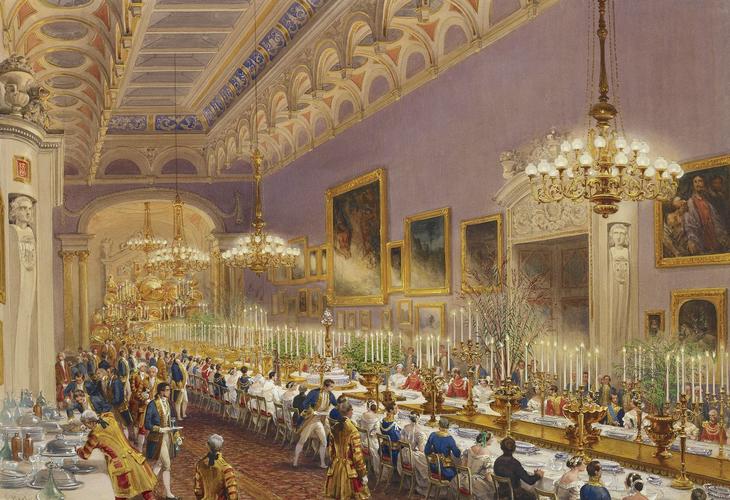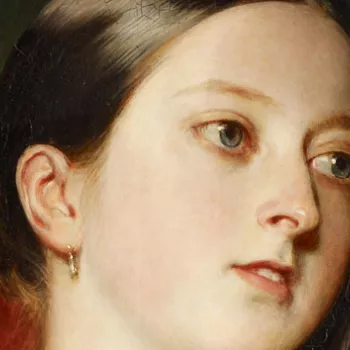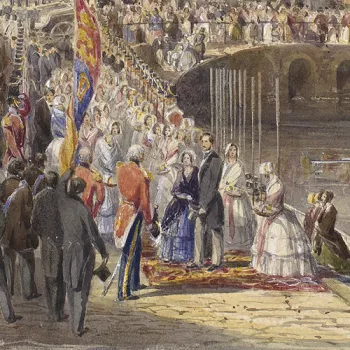The banquet for Prince Leopold's christening, 28 June 1853 dated 1853
Pencil, watercolour and bodycolour | 33.0 x 47.4 cm (sheet of paper) | RCIN 919917
-
A watercolour depicting the Picture Gallery, a long high hall with an enormously long table with candles and china. The grand buffet at far end contains much gilt. Several pictures are on the walls. Queen Victoria sat between King George V of Hanover and the Prince of Prussia, godfathers to Prince Leopold. Signed and dated at bottom left: L. Haghe. / 1853.
This watercolour shows the Picture Gallery at Buckingham Palace. When George IV decided to make Buckingham House into a state palace, one of the stipulations was that his architect John Nash should provide a suitable gallery, particularly for his larger pictures. The drawback of Carlton House had been that it possessed no room large enough for big pictures; and even Wyatville's new gallery at Windsor, the Grand Corridor, could only hold pictures of a relatively modest size. At Buckingham Palace, Nash contrived an enormous new space by throwing together all of Queen Charlotte's suite of rooms on the west side of old Buckingham House to create a gallery over 45 metres in length, top-lit by two rows of glazed saucer domes running down either side. The sub-divided central lantern was added by Blore in the 1830s and altered by Pennethorne in the 1850s. Until the building of the new Ballroom in the early 1850s, the Picture Gallery served as the setting for state banquets and large official or family gatherings. On such occasions the table was laid (as for banquets today) with silver gilt from George IV's collection; for Prince Leopold's Christening Banquet held on 28 June 1853, the Rundell shell tureens were in use.
The picture hang in the new Gallery, established by Prince Albert early in Queen Victoria's reign, combined large and small paintings in anything up to four rows, drawn mainly from George IV's incomparable collection of British, Dutch and Flemish genre pictures, but also including portraits by Reynolds and Zoffany's Tribuna. By 1851, most of the British paintings had been removed and the arrangement made more uniform and permanent by the provision of matching gilt composition frames. Since the death of Queen Victoria, hanging styles have varied greatly, ranging from the density of Edward VII's rearrangement to the sparser hang characteristic of the late twentieth century. The wall treatment has been equally varied. In the 1840s the Gallery was hung with yellow silk; by 1853 a violet or dove-coloured paint was in use; and in 1914, when the roof was entirely remodelled and other alterations made, the walls were changed to green silk. In modern times a pink flock paper has been in use.
This watercolour was originally mounted in View Album VI. Queen Victoria and Prince Albert compiled nine View Albums during their marriage. These albums contained watercolours and drawings documenting their life together and were arranged in chronological order. The albums were dismantled in the early twentieth century and rebound in new volumes both in a different arrangement and with additional items, but a written record of their original contents and arrangement still exists.
Text adapted from Victoria & Albert: Art & Love, London, 2010Provenance
Commissioned by Queen Victoria for her View Album; on 25 August 1853 Haghe was paid £40 for this watercolour
-
Creator(s)
-
Medium and techniques
Pencil, watercolour and bodycolour
Measurements
33.0 x 47.4 cm (sheet of paper)
Other number(s)
RL 19917Alternative title(s)
Buckingham Palace: the christening banquet for Prince Leopold, 28 June 1853











